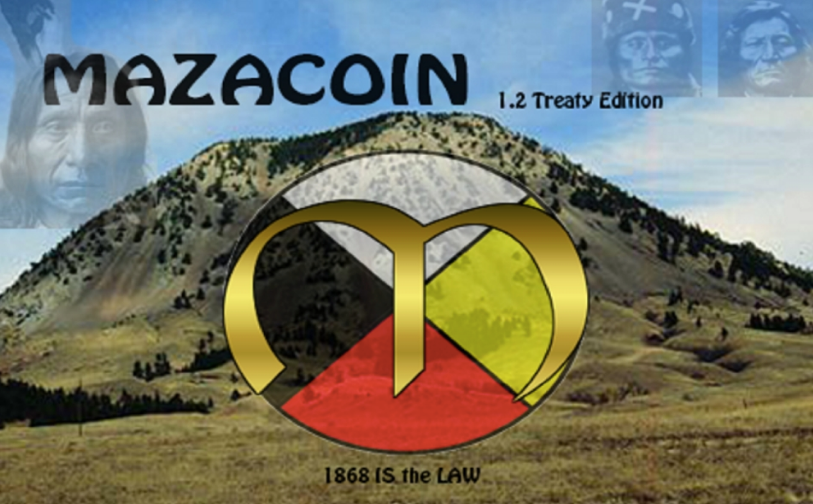Latest news about Bitcoin and all cryptocurrencies. Your daily crypto news habit.

The story of the rise and fall of MazaCoin is fascinating for how it tried to unite two disparate communities: cryptocurrency enthusiasts and members of a North American tribal nation looking to protect a traditional culture.
Over the past several decades, financial and information technologies have evolved from corporate finance and international trade to include microlending and person-to-person digital financial transfers.
Opinions on these developments run the gamut from hypercritical to the techno-libertarianism associated with Silicon Valley.
Given the wide variety of views, it’s fascinating to discover a project that attempted to bridge two seemingly opposed ideologies: the libertarian and individualistic ethos of cryptocurrency, and a local tribal community’s desire to protect their traditional culture.
Cultural Convergence or Cultural Clash?
MazaCoin launched officially on February 20th, 2014 and proclaimed itself to be a“sovereign altcoin for native Americans.” MazaCoin was described in media reports as a “Bitcoin spinoff” that had been adopted by “tribes” in the United States as a national currency. On 27 February 2014, The entrepreneur behind MazaCoin, Payu Harris declared it the national currency of the Lakota Nation of the Pine Ridge Indian Reservation.
Harris himself claimed to be a member of the Lakota Nation. An article in Forbes even described him as a Lakota “chief”. In PR for the MazaCoin project, Harris talked about the “crushing poverty” of the Lakota, whose reservation is located in the second poorest county in the United States. On 27 February 2014, he declared MazaCoin the national currency of the Lakota Nation.
Harris claimed MazaCoin would be a way for the Lakota to achieve financial autonomy:
[A]n independent cryptocurrency would eliminate the State/Federal ability to freeze [tribal community] accounts and tamper with lawful tax revenues.
He insisted as many as 50% of reservation merchants would buy into the system within the first 12 months and that the cryptocurrency would be standard for all indigenous communities within 10 years.
Between February and March 2014, Harris did many interviews. During that time MazaCoin was also trading well on exchanges, propelled by the image of a small Native American tribe’s resistance against the federal government. The story was a good fit with capitalist narratives of self-reliance, libertarianism, and anti-government feeling.
The Other Side of the Coin
However, a different picture was emerging at the same time. On March 7th, 2014, Native Sun News ran an article stating:
The [Lakota] Tribe supposedly launched its own national currency. However, no one bothered to inform Tribal President Bryan Brewer or the [Lakota] Council.
The article reported that while Forbes identified Payu Harris as a chief of the Lakota at Pine Ridge, his name didn’t appear anywhere on tribal membership rolls. Word spread through online forums and in the Pine Ridge community that Harris had overstepped. Speculation started that he might be a con artist.
Less than two weeks after the Native Sun News article, MazaCoin’s value collapsed. A few weeks later, the project was declared all but dead. MazaCoin’s website and social media accounts were deleted.
In 2015, the project returned, rebranded as simply ‘Maza.’ Harris claimed the coin was making a comeback and the open source code was moved to GitHub. New PR material described it more broadly as an indigenous cryptocurrency, not specifically for the Lakota. However, there is still little public information available about the development team or sponsors. Currently, Maza is listed on one small exchange, and at the time of this writing its market on there was “paused”
Two Worlds Collide
Financial technologies embody social relations around money. The design of these technologies, from cash to publicly-traded corporate securities to newer ‘alt-finance’ innovations, reflect social values. For example, the Bitcoin narrative is highly individualistic, rooted in libertarian notions of individual value in opposition to corrupt, outdated governmental institutions.
At the same time, cryptocurrencies require high-level computer skills and lots of computational and electrical power to maintain. Despite the claims of decentralization and democratic control, cryptocurrency requires a technological elite beyond the reach of political institutions.
The early discussion of MazaCoin combined these two visions: the spontaneous ground-up action of non-elites and a high-profile individual leader; anti-government rhetoric and an apparent governmental endorsement; sophisticated hardware and software for a region noted for its poverty.
This ideological mash-up is evident on Maza’s web site:
Maza is like a new kind of currency for a new economy. It is being used by a social movement that has already built a new economy in the midst of the old. It is an economy focused on local community, inspired by ancient traditions and implemented using innovative economic ideas we developed over generations. The Maza economy is more sustainable, more resilient, more prosperous, more accessible and more fair than the old economy. Welcome to a new age … .
Unlike the original MazaCoin branding, there is no reference to the “National Currency of the Oglala Lakota Nation.” Instead, Maza’s purpose is to be a “ticketing solution for Native and non-Native events, Concerts, shows, Powwows, and even Hotel/Resort Booking.” Unlike the original Web site, there are no declarations of sovereignty. Talk is limited to economics with no explicit political dimension. It appears the audience is no longer the Pine Ridge Oglala Lakota, but an alt-currency audience looking for investment opportunities.
Conclusion
While the underlying technology and ideology of trustless peer-to-peer finance can appeal to financial elites and amateur investors, arguably cryptocurrency and the economic and social needs of the Lakota were incommensurable. While MazaCoin was able to attract initial investor interest, its failure was in not being connected with the needs of its intended beneficiaries.
Background research for this article can be found here.
Subscribe to my Medium and Twitter channels if you want to learn more about blockchain and cryptocurrency projects.If you have any questions about this article, please comment in the section below. Thank you!
The Rise and Fall of an Indigenous Cryptocurrency was originally published in Hacker Noon on Medium, where people are continuing the conversation by highlighting and responding to this story.
Disclaimer
The views and opinions expressed in this article are solely those of the authors and do not reflect the views of Bitcoin Insider. Every investment and trading move involves risk - this is especially true for cryptocurrencies given their volatility. We strongly advise our readers to conduct their own research when making a decision.

